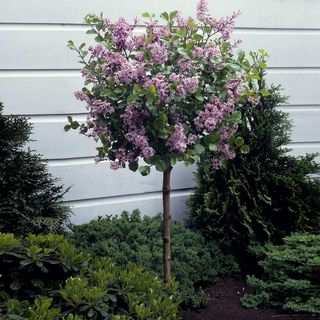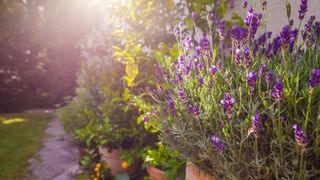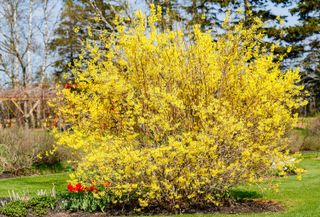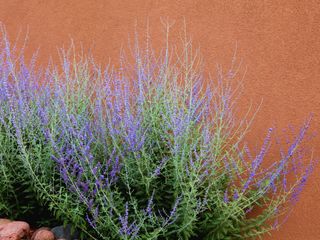7 Plants You Should Never Prune in October — Here's Why Cutting Back May Damage Your Blooms
A gardening expert shares their expertise on certain plants and their pruning needs

The leaves are falling, there’s a chill in the air, and the countdown for Winter has begun — it must be October. Though it might seem like your gardening jobs have come to a screeching halt, now is actually the perfect time to get your yard in order before winter hits. But knowing what to do, or more importantly, what not to do at this time of year, can be a minefield.
Speaking to the experts, it’s pretty clear pruning tops the list for yard jobs in October. This is why knowing how to prune plants is a must. After all, leaving plants like roses to their own devices over winter can lead to all sorts of problems come spring. But for some plants, fall pruning can prove catastrophic to next year’s flowers! So how do you know which plants are destined for the chop and which should be left well alone?
Luckily, with our horticultural expert on hand, you don’t have to guess. They've revealed the top 7 plants that should never be pruned in October. Here's what you need to know.
1. Azalea

An icon of acidic-soiled yards, according to plant expert Sydni D’Amico at Fast Growing Trees, azaleas are one show-stopping flower that should be left well alone at this time of year! "Azaleas bloom on old wood, meaning they bloom on the previous year’s growth, so the timing of pruning is important to preserve the blooms for the upcoming spring," says Sydni. "It is best to avoid pruning them in October and early fall because by doing so, you can cut off all the flower buds and be left with no blooms for the following spring."
According to Sydni, the best time to prune azaleas is right after they finish blooming for the season. So, ensure you know how to care for azaleas to get the best out of this flower. "Some azaleas, such as the Encore® Azalea Shrubs, bloom throughout the year while others, such as Asian Azalea varieties, primarily bloom in spring.’
Instead of pruning your azaleas now, there are other steps you can take to ensure your plant stays in top condition ready to burst into flower come spring. The first Sydni recommends is reducing your watering. "Cut back on the frequency of watering azaleas as the temperatures drop. Since temperatures become colder in fall, and the daylight hours shorter, the soil will not evaporate as much moisture. Apply a 2-3 inch layer of mulch (like this Timberline All Natural Pine Bark Mulch from Walmart) around the base of your azalea to give the roots insulation and prevent cold damage, but avoid applying any fertilizers since that will stimulate unwanted new growth."
2. Echinacea

A favorite with pollinators like bees and butterflies, echinacea (otherwise known as coneflowers) is one plant that relies on dormancy to spring back into life next year. So don’t be tempted to give it a last-minute trim at this time of year, and ensure you take care of these full-sun perennials correctly.
"Pruning Coneflowers in October or early fall is not recommended because it can stimulate the plant to produce new growth when it needs to go dormant for the season," explains Sydni. "New growth produced at this time does not have long enough to harden off before freezing temperatures hit, causing it to die back. This is stressful for the plant because it expends extra energy unnecessarily and can become more susceptible to cold damage."
Instead, Sydni advises leaving these delicate flowers for the wildlife to enjoy throughout fall. She explains: "Leaving the flower stalks intact throughout fall is also beneficial to wildlife, such as birds that use the seedpods as a food source. Native coneflower species will even self-sow their seeds, which is another benefit in leaving the plant untouched throughout fall."
Ok, so if not now, when should you prune your coneflowers? According to expert Sydni, it’s best to leave it until spring — specifically after the last frost in your area. "The best time to prune coneflowers is in early spring after the last frost. If you prefer a cleaner appearance to your garden at this time of year, you can deadhead the flowers as they fade throughout the bloom season." But in our opinion, it’s always great to leave the seedheads for the wildlife to enjoy — especially when food sources are typically low at this time of year. But if you're looking to collect seeds from coneflowers to harvest, now would be the time to do so.
3. Lilacs

These trending California lilac plants are timelessly romantic. Lilacs are one flower that shouldn’t be missed come spring. They're also known to be a trending California lilac plant. And if you want to keep these flowers intact for next year, they’re best kept off your fall pruning list.
"Lilac trees and shrubs begin to set their flower buds for next year after they finish blooming for the current season. Because of this, it is important to avoid pruning in October and early fall to prevent cutting off all of the forming buds — doing so would result in no flowers the following year," says expert Sydni.
Much like Echinacea, Lilacs also need a period of dormancy to prompt their spring blossoms. Sydni explains, "Pruning at this time of year can stimulate the plant to produce new growth, when it should be going dormant for the season."
Don’t worry if your lilac is still sporting its dead flowers from this year, though. Leave them throughout the winter, and come early spring, when the buds are just starting to bloom, you can carefully deadhead your plant. In the future, though, Sydni’s advice is to prune your lilac in the warmer weather. "The most ideal time to prune lilacs is after they finish flowering in late spring," says Sydni. "Pruning is done to maintain shape and size, rejuvenate older growth, and help prevent disease and fungus such as powdery mildew. Small hand-pruners can be used for stems less than half an inch in diameter, and loppers (like this Anvil Lopper from Amazon) can be used to cut larger woody stems — just make sure to sanitize the blades in between cuts to prevent the spread of disease/fungus."
4. Ornamental Grasses

There are many benefits of ornamental grasses, and to see those benefits, pruning them in October might be a problem for your local wildlife, rather than the plant itself. After all, our yards and plants aren’t just for our enjoyment, they also provide essential food and shelter for birds, small mammals, and insects — making these plants firmly on the do-not-touch list this fall.
Expert Sydni explains that the fall and winter foliage of ornamental grasses provides much-needed shelter for wildlife, such as birds and beneficial garden insects. Syndi notes: "Leaving the foliage intact for the season can also give the roots more insulation and prevent cold damage, especially if you are in a colder climate."
As if the environmental benefits weren’t enough, these grasses will also make your yard look great throughout the colder months — especially when there’s a frost that will make those plumes sparkle. "Pruning ornamental grasses such as Muhly, Maiden, and Fountain grass is not recommended in October or early fall. Ornamental grasses offer appeal and interest in the colder seasons with their large plumes that offer movement and a contrast of texture in the landscape."
Instead, opt for a good ornamental grass haircut in early spring. "The best time to prune ornamental grass is in early spring after the last frost," according to gardening expert Sydni. "Pruning is done to remove last year's dead foliage and make room for the new growth to emerge by freeing up space for sunlight penetration and airflow." Be sure to protect your hands with some sturdy gloves when you do prune, though; the grass blades can be quite sharp. These Rose Pruning Gloves Thorn Proof from Amazon, priced at just $22.99 should do the trick.
5. Lavender

Understanding lavender plant care is essential to keeping these Mediterranean plants looking their best. But as Sydni warns, don’t be tempted to prune them too late in the fall!
Expert Sydni says, "Pruning lavender plants in late October is not recommended because it can cause the plant to become more susceptible to cold damage, especially in colder, more northern climates. Pruning in fall can also stimulate the lavender plant to unnecessarily expend energy on pushing out new growth that will inevitably die off during winter frosts."
If your lavender looks like it's seen better days, though, all isn’t lost. Come spring, when the last frost has passed, you can give them a good prune, and they’ll be ready to burst into new growth. As for the right pruning tool for the job, Sydni thinks hand pruners will be ideal. This Fiskars Bypass Pruner from Walmart is a great choice. Syndi adds: "Pruning is done to remove old, woody stems and promote healthy growth with more blooms. Lavender stems are herbaceous while the older growth gets woodier — however, the stems tend to not get very thick, so hand-pruners can be used for pruning this plant."
6. Forsythia

Instantly recognizable from their sunshine yellow blossoms, forsythia — also a great living privacy fence — is another shrub that shouldn’t be pruned in fall. Especially not if you want those gorgeous yellow blossoms in the spring.
Much like lilacs, as Sydni explains, "Forsythias bloom on old wood, so they begin to form the flower buds for next year after they finish blooming — this is why you should not prune them in October. If pruning is done in early fall that can result in no blooms the following spring! It is also recommended to avoid early fall pruning because it can stimulate new growth when the plant should be focusing on going dormant."
Instead of pruning your forsythia at this time of year, Sydni recommends preparing your shrub for the cold weather with a good mulch. "Apply a 2-3 inch layer of mulch around the base of your forsythia to give the roots insulation and prevent cold damage,’ says Sydni. "Don’t be tempted to apply any fertilizers though, that will stimulate unwanted new growth."
If you’re looking for a good mulch choice, you can’t go wrong with rich homemade compost. Failing that, well-rotted manure or bark from the garden center will also be great in keeping your plant in top condition over fall and winter.
7. Russian Sage

Known for its beautiful purple-spired summer flowers, this lavender alternative is a pretty perennial that definitely should not be pruned in fall — especially if you want your plants to survive harsh weather.
Sydni says you should avoid pruning Russian Sage in October because letting them be for the cold winter months is known to increase their hardiness. "Holding off on early fall pruning also gives the landscape winter appeal due to their showy silver-green stems, which can also serve as cover for birds and beneficial insects."
Instead, mark early spring in your calendar as the time to give Russian sage a good prune. Look out for the new growth emerging from the base of the plant and take the old stems back to about 20cm from the ground.
As Sydni highlights, pruning Russian sage is an important part of maintaining this plant, so don’t be tempted to skip it entirely. She tells us: "Pruning Russian sage is done to maintain the plant’s size and shape, stimulate more vigorous growth, profuse blooms, and prevent 'flopping' which can occur when the stems are weak and flop down from the weight of the flowers."
Be The First To Know
The Livingetc newsletter is your shortcut to the now and the next in home design. Subscribe today to receive a stunning free 200-page book of the best homes from around the world.
Matilda Bourne is a freelance homes, gardens and food writer, stylist and photographer. Known for creating and capturing content for multiple international brands, her work has been featured in The Telegraph, The Daily Mail, and Hello! magazine. When she’s not writing, you can usually find her tending to her much-loved garden and scouring thrift stores for vintage furniture.
-
 The Best Spas in the UK? These 10 Awe-Inspiring Destinations Where Wellness and Design Unite
The Best Spas in the UK? These 10 Awe-Inspiring Destinations Where Wellness and Design UniteLose yourself in the atmosphere of the best spas in England and beyond, each selected for their soothing and entrancing interiors
By Gilda Bruno Published
-
 How to Clean Shutters Properly, Without It Feeling Like Your Home's Most Tedious Chore
How to Clean Shutters Properly, Without It Feeling Like Your Home's Most Tedious ChoreHere's an easy guide to cleaning your window shutters that won't have you dreading this regular task
By Seraphina Kyprios Published
-
 How to Clean Shutters Properly, Without It Feeling Like Your Home's Most Tedious Chore
How to Clean Shutters Properly, Without It Feeling Like Your Home's Most Tedious ChoreHere's an easy guide to cleaning your window shutters that won't have you dreading this regular task
By Seraphina Kyprios Published
-
 3 Places You Just Have to Have a Rug, According to Feng Shui — Or Else Risk Your Home's Positive Energy
3 Places You Just Have to Have a Rug, According to Feng Shui — Or Else Risk Your Home's Positive EnergyIntroduce vibrant energy into different parts of the home using these easy rug tips from our experts
By Maya Glantz Published
-
 "I'm a Plant Stylist, These Are the Mistakes Making Your Houseplants Look Messy, Awkward, and Lifeless"
"I'm a Plant Stylist, These Are the Mistakes Making Your Houseplants Look Messy, Awkward, and Lifeless"If you're guilty of any of these houseplant styling faux pas, now's the time to switch it up
By Amiya Baratan Published
-
 How Often Should You Declutter? How to Tell If You're Doing Too Little, or Way Too Much, According to Professional Organizers
How Often Should You Declutter? How to Tell If You're Doing Too Little, or Way Too Much, According to Professional OrganizersA regularly decluttered home is a space filled with less clutter anxiety and more focus and clarity, say experts
By Ciéra Cree Published
-
 How to Clean Outdoor Limestone Paving — To Get It Look Back to Its Best Ahead of Spring
How to Clean Outdoor Limestone Paving — To Get It Look Back to Its Best Ahead of SpringProtect your outdoor limestone by incorporating these simple cleaning tips
By Seraphina Kyprios Published
-
 How to Clean Metal Garden Furniture — And Prepare Your Space for Al Fresco Dining
How to Clean Metal Garden Furniture — And Prepare Your Space for Al Fresco DiningAn expert guide to freshen up your furniture for the seasons ahead and get ready for those lavished outdoor dinner parties
By Jacky Parker Published
-
 How to Declutter Your Home in One Weekend — This Is the Reset You Need to Fix a Chaotic Home
How to Declutter Your Home in One Weekend — This Is the Reset You Need to Fix a Chaotic HomeHere's how experts use two reset days to cut clutter from every room in a busy home
By Amiya Baratan Published
-
 7 Things Minimalists Throw Out Every Day for a Tidier Home — That You Should, Too
7 Things Minimalists Throw Out Every Day for a Tidier Home — That You Should, TooThese things take mere moments to remove from your home but are a great start to having a tidier space
By Ciéra Cree Published